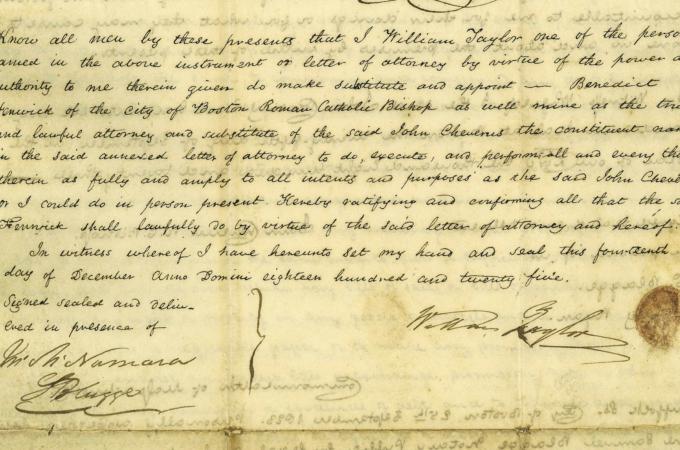The choice of Bishop Cheverus' successor
The Diocese of Boston's first bishop, Bishop Jean Cheverus, departed for his native France in the autumn of 1823. When he did so, he left the diocese uncertain whether or not he would return, and his successor, Bishop Benedict Joseph Fenwick, would not arrive to assume this role for over two years following his departure. In the interim, the Diocese of Boston was largely overseen by a priest, and Bishop Cheverus' choice as his successor, Father William Taylor.
Father Taylor was born in Castlemartin, County Kildare, Ireland, to a Protestant family. He entered Trinity College, Dublin, where it is believed he converted to Catholicism, and later entered the seminary at Maynooth. While studying, there appears to have been some concern over his continued sympathy for the Protestant faith, and these concerns were enough to allow Bishop William Coppinger of Cloyne to allow him to depart for the United States.
He was received by Bishop John Connolly of New York, and while there, would attempt to publish a book called "The Christian's Monitor, or Practical Guide to the Happiness; a new Roman Catholic Prayer Book" in 1819. Clergy who wrote theological texts had to have them approved by their bishop, the responsibility in this instance resting with Archbishop Ambrose Marechal of Baltimore who did not approve of the work, citing a loose knowledge of theology and, specifically, the incorporation of ideas from the Protestant faith.
His situation in New York would not improve, as he departed for Rome in early 1820 to advocate on behalf of the trustees of St. Peter's Parish. The trustees who cared for the parish largely consisted of affluent individuals who saw Bishop Connolly as being under the influence of the growing Irish Catholic members of the parish. Father Taylor failed to advocate successfully for the trustees, and when he returned, Bishop Connolly refused to restore his faculties as a priest in the diocese.
Father Taylor left New York and arrived in Boston in February 1821, and appealed to Bishop Cheverus for an assignment in the diocese. Before departing for Rome, he had written Bishop Cheverus asking for a letter of support, but the reply he received was one of indifference, Boston's bishop not willing to meddle in New York's affairs. Despite this, he saw much to admire in Father Taylor, and arranged for his transfer to the Diocese of Boston.
Bishop Cheverus described Father Taylor as amiable and pious, and he was known to be well-educated, a great speaker, and well-mannered. While it was seen as a problem earlier, his understanding of the Protestant faith earned him the esteem of non-Catholics as well as Catholics in the Boston community. These fine qualities no doubt explain how by July 1821, he was acting as the bishop's assistant, and on March 8, 1822, was named vicar general of the Diocese of Boston. In November of that year, Bishop Cheverus wrote to Baltimore Archbishop Marechal indicating he would like Father Taylor to be his successor.
By this time, Bishop Cheverus was contemplating a return to his native France. He cited health issues, and it is believed he thought he had accomplished all he could, seeing the diocese's future in the hands of the Irish Catholics, a reason to name Father Taylor as his successor. He also expressed a desire that his successor be someone familiar with the Roman Catholic Church in the United States rather than someone from abroad.
Despite his desire to return home, after listening to the appeal of Boston community, Bishop Cheverus initially rejected his appointment as Bishop of Montaubon, France, and agreed to stay. It appeared he would remain, but several months later he was forcibly recalled by religious leaders in France, departing in 1823, and leaving Father Taylor in charge of the diocese in his absence.
With uncertainty over Bishop Cheverus' return, Father Taylor worked to maintain the status quo. When the Baptist "Society for the Benefit of the Penobscot Indians" established a school in Old Town, Maine, an area previously served by Catholic missionaries, he sent Father Patrick Byrne to evaluate the situation. He is also known to have written the Archbishop of Baltimore requesting additional priests to help him serve this immense diocese covering all of New England.
By early 1824, it did not appear that Bishop Cheverus would return, and discussions began to take place to name his successor. While it was known Father Taylor was Cheverus' choice, and he received positive recommendations from several other clergy members, none of the bishops from the United States are believed to have expressed confidence in him. Despite his gifts, the ideas expressed in his attempted publication, and in some of his orations, were controversial. What probably most caused this lack of confidence was the bishops' recollections of his opposition to the authority of Bishop Connolly in New York several years earlier.
Father Benedict Joseph Fenwick, a Jesuit priest from Maryland, was eventually named as the new Bishop of Boston. Word arrived from Bishop Fenwick himself in September 1825, and Father Taylor announced the news to his congregation on the 17th of that month. There is no doubt that many of the Catholics in the diocese were disconcerted by the news; they had always seen Father Taylor as Bishop Cheverus' natural successor, but it was not to be. Bishop Fenwick arrived on Nov. 30, 1825, and said his first Mass at the Cathedral of the Holy Cross on Franklin Street on Sunday, Dec. 4. Father Taylor departed two weeks later, wishing to rejoin Bishop Cheverus in France. He would pass away on Aug. 1, 1828, in Paris, France.
- Thomas Lester is the archivist of the Archdiocese of Boston.



















